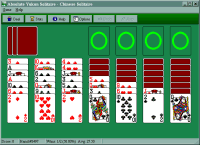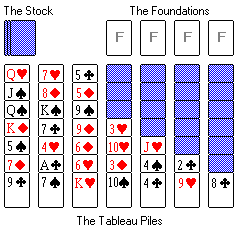Chinese Solitaire Rules
 This game was suggested by James Jonte (jjonte@orbitworld.net). Here's how
he described it to me:
This game was suggested by James Jonte (jjonte@orbitworld.net). Here's how
he described it to me:
"Years ago an Oriental girl taught me a game of solitaire that she called "Chinese Solitaire" I have never seen another game quite like this one. If you are interested I thought this might be a fun game for others to play. I have enjoyed it since 1972."
He went on to describe the game, which I then tried with a deck of real cards. I was immediately intrigued by the gameplay, and searched through a half-dozen solitaire reference books, figuring that a game this good just had to have been described before ... but I found nothing.
This game plays like a cross between "Klondike" and "Scorpion", two of the very best and most popular solitaires. It offers ample opportunity for skill, yet it's very winnable.
Setup
The game is begun by dealing forty-nine cards to the tableau, arranged as seven stacks of seven cards each. The first three stacks are deal with all cards face up; the fourth has three cards face down and four face up; the fifth has four cards face down and three face up; the sixth has five cards face down and two face up; and the seventh has six cards face down and one face up. The three remaining cards are set aside to form the stock.

The object of the game is to arrange the cards into four foundation suits, running from ace to king. The foundations may be placed in any order. (The layout shown above is winnable, by the way (it's hand #1 in my computer version of the game).
Play
Cards on the tableau may be moved from one tableau to another, either singly or in blocks. Play cards in alternating colors and descending rank. For example, a four of diamonds may be played on a five of clubs.
As the face-down cards are uncovered, they are automatically turned face-up and become available for play.
If a tableau space is created, only kings may be moved to the empty space (unless "easy mode" is enabled).
When you have exhausted all the plays among the tableaus and foundations, deal the last three cards from the stock pile to the first three tableaus. (Actually, you can use the stock at any time, even if move moves are available -- it's just not a particularly good idea ...).
If you manage to move all the cards to the foundations, you win!
Strategy
The strategy I find most useful is to make sure the face-down cards get turned over as quickly as possible. The sooner you can get all cards into view the better. Often you'll be forced to choose between moving a card to a foundation, or exposing a face-down card. Try to resist the urge for instant gratification, and take a step into the unknown ...
Managing the three stock cards can also be worked to your advantage. In general, don't use them until you have to, and when you do, try to arrange the first three tableau piles so that the incoming stock cards can do as little damage as possible. That is, if the bottom of the first tableau pile contains a card you're likely to need soon, try creating a space and moving the pile into the empty space. Often this is not possible, but occasionally it will work out.
Try to keep the four foundations relatively "even". That is, don't allow one foundation pile to be built up while the other three languish. If you do that, you'll find yourself needing one of the cards that you already played to the foundation.
On the other hand, it's sometimes safe to build up two foundations (a red and a black) in sync, while the other two are relatively empty. In fact, as you near the end of a hand, this is often the only way to expose badly-needed face-down cards.
Finally, management of tableau spaces is very important to success. Try to create a space as soon as possible -- unless, of course, there are no exposed kings. In that case, creating a space would do you no good at all. But that's a relatively rare phenomenon ...
Odds
James Jonte reported that he wins roughly 33% of the time, and my own play has borne this out, though using "easy" mode (being able to move any cards -- not just kings -- to spaces) does improve the odds a bit. At the time of this writing, my statistics are:
- Games Played: 355
- Games Won: 179
- Winning Percentage: 50.42%
- Average Score: 29.97
Other Sources of Chinese Solitaire Rules
Note: All rule links open in a new window.
